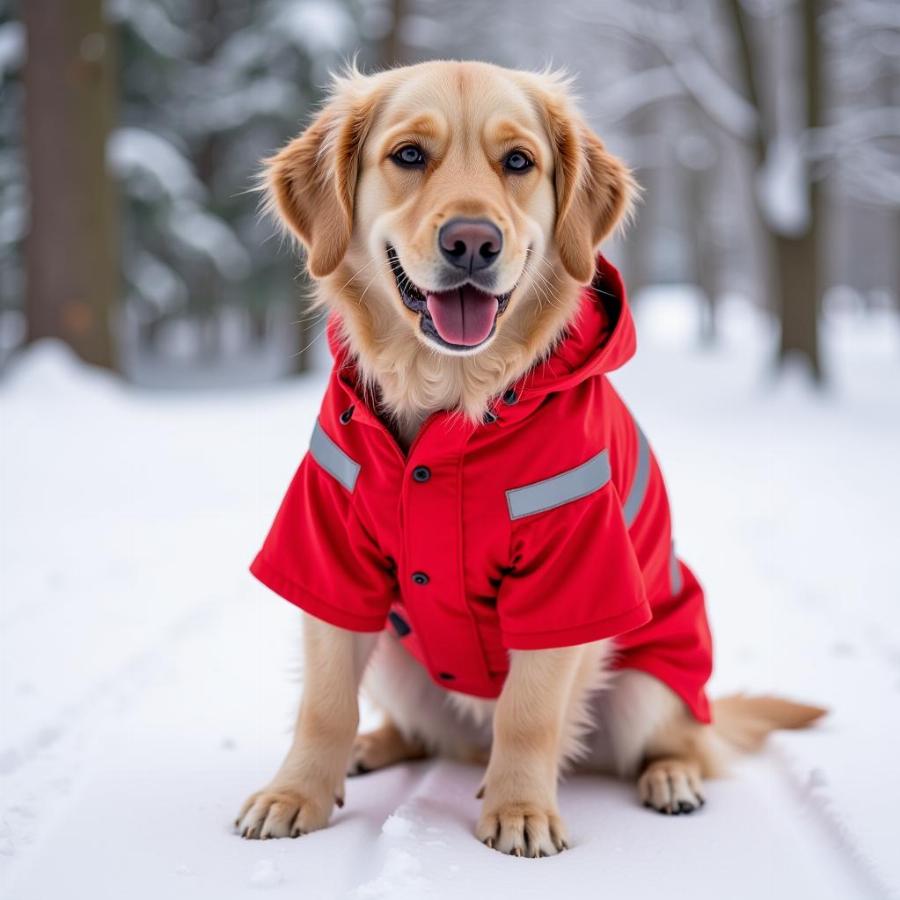As the temperature drops and snowflakes start to fall, it’s time to bundle up – not just for you, but for your furry friend too! If you live in an area that experiences winter weather, a dog jacket for snow is a must-have item to keep your pup warm, comfortable, and protected from the elements. But with so many options available, choosing the right one can be overwhelming.
This comprehensive guide will walk you through everything you need to know about dog jackets for snow, from understanding the benefits to selecting the perfect fit and style for your canine companion.
Why Your Dog Needs a Jacket in the Snow
While some dog breeds are naturally equipped with thick double coats that provide insulation against the cold (think Huskies and Malamutes), many others are more susceptible to the chill.
Here’s why a dog jacket for snow is beneficial:
- Warmth and Insulation: A well-designed jacket acts as a barrier against the cold, trapping your dog’s body heat and preventing heat loss. This is particularly important for small breeds, short-haired dogs, and senior dogs who are more sensitive to temperature fluctuations.
- Protection from the Elements: Snow, sleet, and freezing rain can be harsh on your dog’s skin and fur. A waterproof and windproof jacket provides a protective layer, keeping your pup dry and comfortable even in the worst weather.
- Visibility in Low Light: Winter days are often shorter and darker. A jacket with reflective strips or bright colors increases your dog’s visibility during walks, making them easier to spot by motorists and other pedestrians.
 Dog Wearing Red Snow Jacket
Dog Wearing Red Snow Jacket
Choosing the Right Dog Jacket for Snow
Finding the perfect dog jacket for snow involves considering your dog’s individual needs and preferences. Here’s a breakdown of the key factors:
1. Size and Fit:
A properly fitted jacket should be snug but not restrictive, allowing for freedom of movement. To determine the right size, you’ll need to measure your dog’s:
- Neck Girth: Measure around the base of the neck where the collar usually sits.
- Chest Girth: Measure around the widest part of the chest, just behind the front legs.
- Back Length: Measure from the base of the neck to the base of the tail.
Always refer to the manufacturer’s size chart and consider your dog’s build. If your dog falls between sizes, it’s generally best to size up.
2. Material and Construction:
- Outer Shell: Look for durable, water-resistant, and windproof materials like nylon or polyester. Some jackets even offer waterproof breathable fabrics for added comfort.
- Insulation: The level of insulation needed will depend on your climate and your dog’s cold tolerance. For very cold weather, consider jackets with fleece lining or synthetic insulation like Thinsulate.
- Lining: A soft, comfortable lining will prevent chafing and keep your dog cozy. Fleece and sherpa are popular choices for their warmth and softness.
3. Style and Features:
- Jacket Style: Dog jackets for snow come in a variety of styles, including vests, coats, and parkas. Vests offer core warmth, while coats and parkas provide more coverage.
- Closure Type: Consider whether you prefer a zipper, Velcro, or buckle closure. Zippers offer a secure fit, while Velcro allows for easy on and off.
- Additional Features: Some jackets come with added features like hoods for extra warmth, leash attachments for convenience, and pockets for storing treats or waste bags.
Tips for Putting on a Dog Jacket
- Positive Reinforcement: Make the experience positive for your dog by using treats, praise, and a gentle touch.
- Gradual Introduction: If your dog is new to wearing a jacket, introduce it gradually by letting them sniff it and wear it for short periods indoors before venturing outside.
- Check for Comfort: Once the jacket is on, ensure it fits properly and doesn’t restrict movement. Watch for any signs of discomfort, such as excessive panting or attempts to remove the jacket.
Caring for Your Dog’s Snow Jacket
- Regular Cleaning: Most dog jackets can be machine washed on a gentle cycle. Always follow the care instructions on the label.
- Air Dry: Hang the jacket to air dry completely after washing to prevent mold or mildew growth.
- Inspection: Regularly check the jacket for any tears, rips, or damage to the closures.
Frequently Asked Questions About Dog Jackets for Snow
Q: Does my dog really need a jacket if they have a thick coat?
A: Even dogs with thick coats can benefit from the added warmth and protection of a jacket in extremely cold or wet conditions.
Q: How can I tell if my dog is cold?
A: Signs your dog may be cold include shivering, hunching over, lifting their paws off the ground, and seeking warmth.
Q: What should I do if my dog refuses to wear a jacket?
A: Try a different style or size jacket, use positive reinforcement during the introduction process, and consult with a veterinarian or certified dog trainer for additional guidance.
Keep Your Canine Cozy This Winter
A dog jacket for snow is a worthwhile investment for any dog owner living in a cold climate. By choosing the right jacket and following these care tips, you can help your furry friend stay warm, safe, and stylish all winter long.
Remember, every dog is unique, so what works for one may not work for another. Pay attention to your dog’s cues and adjust accordingly.
Need more help navigating the world of dog care? Beaut Dogs is here to guide you! We offer a wealth of resources on everything from breed-specific information to expert advice on nutrition, training, and more.
Visit https://beautdogs.com today to discover the joys and responsibilities of being a responsible dog owner! For personalized support, reach out to our team at [email protected]. We’re always happy to help you provide the best possible care for your beloved canine companion.